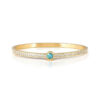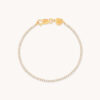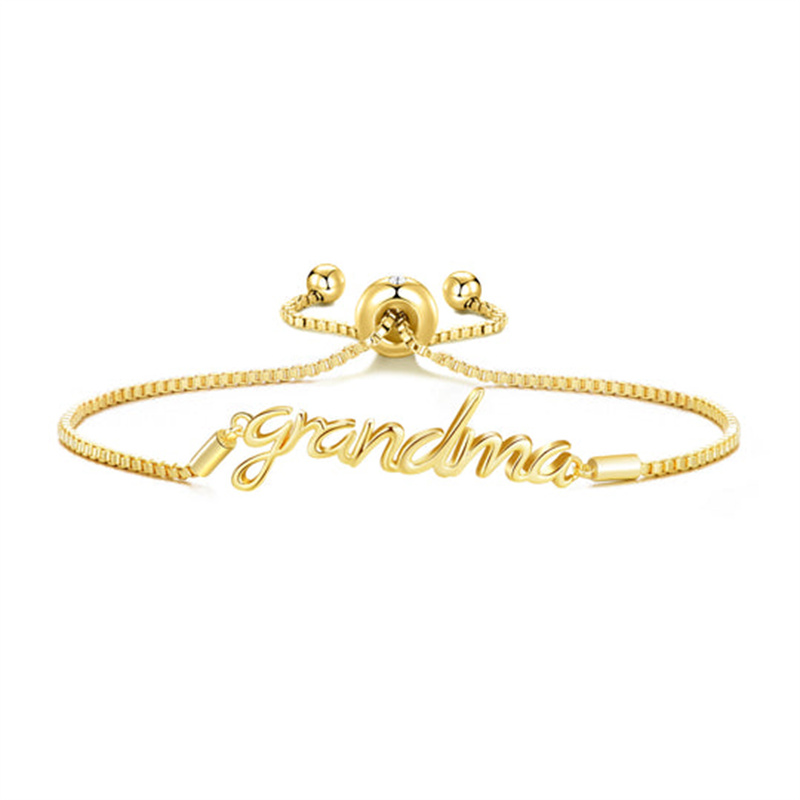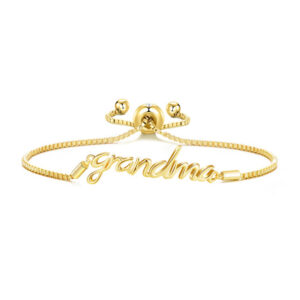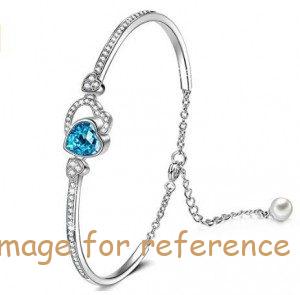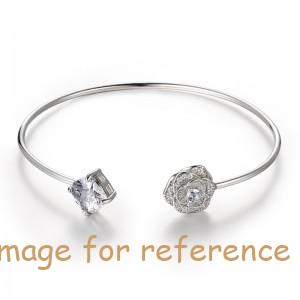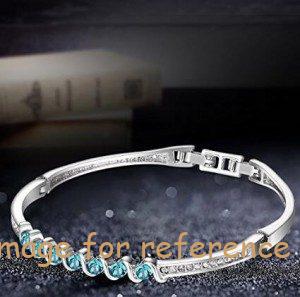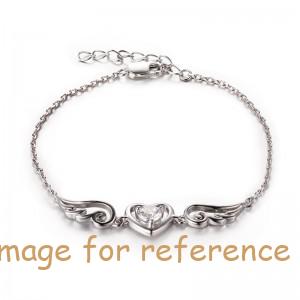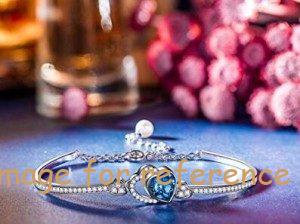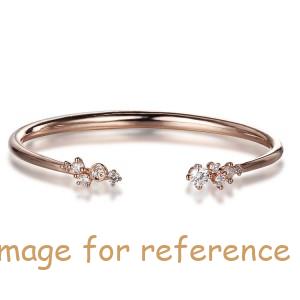Jingying:O fabricante de joias OEM ODM com pulseira de letras banhadas a ouro
OEM/ODM Jóias Fabricante Design personalizado suas próprias jóias
Vamos começar : mo@kingjy.com
Jingying: A Arte da Personalização – Uma jornada de fabricação de pulseiras banhadas a ouro OEM / ODM
No cenário vibrante e em constante evolução das joias da moda, poucos itens possuem o poder único da pulseira de letras. É uma peça que transcende o mero adorno, tornando-se uma tela para identidade, conexão, e narrativa pessoal. Quer soletre um nome, uma palavra significativa, uma inicial, ou uma mensagem secreta, carrega uma história no pulso. Para marcas que buscam capitalizar esta tendência profunda, a jornada desde a centelha de uma ideia até um produto pronto para prateleira é habilmente facilitada por um fabricante especializado de joias OEM/ODM.
O termo chinês “Jingying” (negócios) incorpora os conceitos de operação, gerenciamento, e cultivo meticuloso. UM “Jingying” fabricante não se limita a montar produtos; cultiva parcerias, gerencia cadeias de suprimentos complexas, e opera com uma filosofia de melhoria contínua e serviço centrado no cliente. Este artigo fornecerá uma exaustiva, exploração dos bastidores do OEM (Fabricante de equipamentos originais) e ODM (Fabricante de design original) processos para criar uma pulseira com letras banhada a ouro personalizada. Vamos dissecar cada etapa, desde o conceito inicial até o produto final embalado, revelando a intrincada mistura de tecnologia, arte, e gestão estratégica que define esse nicho fabril.
Fase 1: A fundação – OEM vs.. ODM e a Parceria Inicial
Compreender a distinção entre OEM e ODM é crucial, pois define a natureza do relacionamento cliente-fabricante desde o início.
OEM (Fabricação de equipamentos originais): O projeto do cliente
Em um modelo OEM, o cliente chega ao fabricante com um design totalmente ou amplamente desenvolvido. Eles fornecem especificações detalhadas, Desenhos técnicos, ou mesmo uma amostra física. O papel do fabricante é executar este projeto com precisão, adquirir materiais e gerenciar a produção de acordo com as instruções explícitas do cliente. Para uma pulseira de carta, isso pode significar que uma marca fornece o arquivo de fonte exato das letras, as dimensões precisas dos elos da corrente, e o tipo específico de revestimento de ouro necessário.
ODM (Fabricação de design original): A inovação do fabricante
Em um modelo ODM, o cliente aproveita a experiência de design existente do fabricante, R&Capacidades D, e bibliotecas de produtos. Uma marca pode abordar o fabricante com uma necessidade de mercado –”queremos uma linha da moda, pulseiras delicadas com letras para jovens adultos”—e o fabricante apresentará uma gama de opções pré-concebidas para personalização. O cliente pode então selecionar um modelo base, modifique-o (Por exemplo, mudar o estilo da corrente, a fonte das letras, ou o fecho), e marcá-lo como seu. Este é um modelo muito mais colaborativo e eficiente para clientes que podem não ter recursos de design internos.
Etapa 1: A Consulta Inicial & Escopo do Projeto
O processo começa com uma conversa aprofundada para alinhar a visão com a viabilidade.
-
Visão do cliente: O cliente é um parceiro OEM com especificações rígidas?, ou um parceiro ODM em busca de informações criativas?
-
Estilo pulseira: As principais considerações incluem:
-
Formulário de carta: As letras são amuletos individuais pendurados em uma corrente? São links interligados que formam uma palavra? Eles estão estampados em uma barra plana?
-
Tipo de corrente: Uma delicada corrente de cabos, uma corrente de corda resistente, uma corrente de cobra moderna, ou uma corrente de caixa? A escolha impacta o estilo da pulseira, durabilidade, e sentir.
-
Mecanismo de Fecho: Um simples fecho de anel de mola, um fecho lagosta seguro, um fecho decorativo, ou um sofisticado fecho de caixa com trava de segurança?
-
-
Especificações do material:
-
Metal base: Este é o material do núcleo que será revestido. As escolhas mais comuns são:
-
Latão: O padrão da indústria para joias folheadas a ouro. É acessível, durável, e aceita o revestimento excepcionalmente bem.
-
Cobre: Também uma excelente base para chapeamento, oferecendo uma superfície muito lisa, mas mais macio que latão.
-
Aço inoxidável: Um prêmio, hipoalergênico, e base extremamente durável. Chapeamento de ouro sobre aço inoxidável (frequentemente chamado de IP ouro, ou revestimento iônico) é mais resistente ao desgaste, mas também mais caro.
-
-
Especificação de revestimento: O tipo e qualidade da camada de ouro.
-
Espessura do revestimento: Medido em microns (Por exemplo, 0.5 microns, 1 Micron, 3 microns). Um revestimento mais espesso dura mais e é mais resistente a manchas. A indústria muitas vezes se refere a isso como “Chapeamento de ouro pesado.”
-
Cor do chapeamento: Ouro amarelo, ouro rosa (uma liga de ouro e cobre), ou ouro branco (uma liga banhada a ouro com ródio para um acabamento branco brilhante).
-
Tipo de chapeamento: Galvanoplastia padrão é comum. For higher-end pieces, PI (Revestimento iônico) or PVD (Deposição de vapor físico) create a more bonded, durável, and scratch-resistant surface.
-
-
-
Volume do pedido & Target Price: The manufacturer must understand the budget and quantity, as this dictates the manufacturing techniques. A order of 50,000 units allows for different tooling and processes than a custom order of 500 pedaços.
Fase 2: The Design and Engineering Blueprint
This phase transforms the conceptual into the technical.
Etapa 2: Finalização do projeto & Modelagem CAD
Whether working from a client’s OEM design or developing an ODM concept, the process culminates in a precise digital model.
-
Font Selection & Vectorization: For letter bracelets, typography is everything. The design team either uses the client’s provided font file or selects an appropriate one from their library (ensuring licensing compliance). Each letter is converted into a clean, manufacturable vector path.
-
3Modelagem CAD D: Usando software CAD especializado em joias (como Rhino Gold ou Matrix), um designer cria um modelo tridimensional de toda a pulseira.
-
Geometria das Letras: O modelo define a espessura, profundidade, e quaisquer chanfros ou bordas decorativas nas letras.
-
Corrente & Engenharia de links: Cada elo da corrente é modelado para garantir movimento suave e integridade estrutural. Para pulseiras de letras interligadas, os pontos de conexão entre cada letra são projetados para serem flexíveis e fortes.
-
Integração de fecho: O fecho é modelado e integrado perfeitamente no design da pulseira.
-
-
Prototipagem Virtual & Renderização: O modelo CAD permite montagem virtual e renderização fotorrealista. O cliente pode ver a pulseira de todos os ângulos, em diferentes cores douradas, e muitas vezes em um “prova virtual” cenário. Esta é a fase para aprovações e ajustes finais antes de qualquer custo físico ser incorrido.
Etapa 3: Cotação & Finalização do Projeto
Com o modelo CAD finalizado, a fábrica pode gerar uma cotação precisa e detalhada.
-
Divisão de custos:
-
Custo do metal básico: Calculado a partir do volume do modelo CAD.
-
Custo de revestimento: Com base na área de superfície e na espessura e tipo de revestimento especificado.
-
Custo de ferramentas/molde: O custo único para criar moldes de fundição ou matrizes de estampagem.
-
Custo da mão -de -obra: Amostragem abrangente, elenco, conjunto, polimento, revestimento, e controle de qualidade.
-
Custo de embalagem.
-
-
Acordo de cronograma: Um cronograma de produção é estabelecido, delineando os principais marcos desde a amostragem até a entrega final.
-
Assinatura de Contrato: Um acordo formal é assinado, travando em todas as especificações, custos, Linhas do tempo, e termos de qualidade.
Fase 3: A fase de prototipagem – Uma realidade física
Etapa 4: Fabricação de amostras – O “Primeiro artigo”
Uma amostra física é criada para validar o design, sentir, e qualidade.
-
3D impressão (Prototipagem rápida): O arquivo CAD é enviado para uma impressora 3D de alta resolução, que cria um modelo de resina da pulseira. Esta é uma maneira rápida e precisa de verificar o formulário, a clareza da fonte, e as proporções globais.
-
Fundição de Amostra & Conjunto: O modelo de resina é usado para criar um molde mestre, e um pequeno lote de amostras é fundido no metal base especificado (Por exemplo, latão). Essas amostras são então acabadas à mão, montado, e banhado de acordo com o padrão acordado.
-
O “Amostra de Ouro”: Esta amostra finalizada, espelhando a peça de produção final, é enviado ao cliente para aprovação.
Etapa 5: Avaliação de amostra & Aprovação
O cliente realiza uma avaliação rigorosa da amostra:
-
Fidelidade de design: A fonte parece correta? O tamanho e a proporção estão conforme o esperado?
-
Conforto e desgaste: Como é a sensação no pulso? O fecho é fácil de operar?
-
Qualidade de Acabamento e Revestimento: A cor do banho de ouro está correta?? A superfície é lisa e brilhante?
-
Verificação de durabilidade: Os pontos de conexão são seguros? A corrente parece forte?
O feedback do cliente é incorporado, e se necessário, uma segunda amostra de pré-produção é feita até que a aprovação total seja concedida.
Fase 4: Produção em massa – A Sinfonia do Artesanato
Com uma amostra aprovada, a fábrica passa para a produção em grande escala.
Etapa 6: Ferramentas & Fabricação de Componentes
O método de fabricação depende da complexidade do projeto e do volume do pedido.
-
Elenco (Para designs complexos): O método mais comum para amuletos de letras detalhados e elos de corrente complexos.
-
Fabricação de mofo: Um modelo mestre de metal é criado a partir da amostra aprovada. Este mestre é usado para criar moldes de borracha.
-
Injeção de árvore de cera & Investimento: Réplicas de cera são injetadas nos moldes e montadas em uma “árvore.” A árvore é então colocada em um frasco e cercada por uma camada de gesso.
-
Burnout & Elenco: O frasco está aquecido, derretendo a cera (o “cera perdida” método). O latão fundido é então fundido centrífugamente nas cavidades ocas.
-
Devesting: Uma vez resfriado, o gesso está quebrado, revelando uma árvore de componentes de pulseira de latão bruto.
-
-
Estampagem (para mais simples, designs mais planos): Para pingentes básicos de letras ou pulseiras em barra, matrizes de estampagem de metal são criadas. Uma prensa poderosa carimba as letras em uma folha de latão, que é um método muito rápido e econômico para grandes volumes.
Etapa 7: Acabamento Pré-Montagem
Os componentes brutos fundidos ou estampados são ásperos e requerem limpeza e acabamento extensivos.
-
De-spruing: Os componentes fundidos são cuidadosamente cortados da árvore de fundição.
-
Acabamento oscilante/vibratório: Os componentes são colocados em grandes máquinas rotativas com meio abrasivo, água, e composto. Este processo, que pode durar horas, remove imperfeições de fundição, suaviza bordas, e endurece o metal, dando-lhe um brilho preliminar.
Etapa 8: Conjunto & De solda
Esta é uma fase crítica onde a pulseira toma a sua forma final..
-
Montagem de corrente: Para pulseiras com pingentes, as letras e outros amuletos estão ligados à corrente pré-fabricada. Para pulseiras de letras interligadas, cada letra é meticulosamente ligada à próxima por um montador habilidoso, muitas vezes usando micropinças sob ampliação.
-
De solda: Quaisquer conexões permanentes, como prender anéis de salto que devem ser fechados ou fixar o fecho nas extremidades da corrente, são feitos através de soldagem. Um joalheiro usa uma pequena tocha e solda para criar um forte, vínculo perfeito. Isto requer muita habilidade para evitar derreter os componentes delicados ou descolorir o metal.
Etapa 9: Polimento & Refinamento de superfície
Para obter uma superfície perfeita para revestimento, as pulseiras montadas passam por um polimento meticuloso.
-
Polimento Mecânico: As pulseiras são polidas em rodas motorizadas com diversos tipos de escovas e compostos de polimento (rouge). Esta etapa traz um alto brilho, brilho espelhado no latão.
-
Polimento das mãos: Para áreas complexas ao redor das letras e elos de corrente que as máquinas não conseguem alcançar, polidores experientes realizam polimento manual detalhado.
Etapa 10: Eletroplatação – A Transformação Dourada
Esta é a etapa que dá à pulseira sua aparência final luxuosa.
-
Limpeza Ultrassônica: As pulseiras polidas são cuidadosamente limpas para remover todos os vestígios de composto de polimento, óleo, e poeira. Qualquer contaminação causará falha no revestimento.
-
Eletro-Limpeza: As pulseiras são submersas em um banho eletroquímico para garantir uma superfície perfeitamente imaculada em nível microscópico..
-
Lavagem: Múltiplos enxágues em água deionizada removem todas as soluções de limpeza.
-
O banho de chapeamento: As pulseiras estão imersas na solução folheada a ouro (eletrólito). Eles estão conectados ao cátodo (terminal negativo) de um retificador, enquanto um ânodo de ouro puro (terminal positivo) também é colocado na solução.
-
Aplicando Corrente: Uma corrente elétrica é passada através da solução, fazendo com que os íons de ouro se dissolvam do ânodo e se liguem uniformemente à superfície da pulseira (cátodo).
-
Controle de Processo: A espessura do revestimento é controlada com precisão pela duração da imersão e pela amperagem da corrente. Por um “chapeamento de ouro pesado,” a pulseira permanece no banho por mais tempo.
-
Enxágue pós-revestimento & Neutralização: Após o chapeamento, as pulseiras são enxaguadas novamente e frequentemente tratadas em banho de neutralização para estabilizar a camada de revestimento.
-
Acabamento opcional: Para maior resistência a manchas, um claro, revestimento protetor anti-manchas (como EPXY) pode ser aplicado.
Fase 5: A contagem regressiva final – Qualidade, Marca, e entrega
UM “Jingying” o fabricante se distingue por um regime de controle de qualidade intransigente.
Etapa 11: Garantia de qualidade rigorosa
Cada pulseira é inspecionada de acordo com uma lista de verificação multiponto:
-
Qualidade de chapeamento: Verifique a consistência da cor, cobertura (sem pontos perdidos), e ausência de descamação, borbulhando, ou descoloração.
-
Defeitos de Superfície: Inspeção de arranhões, Pits, ou marcas de polimento que foram perdidas.
-
Integridade estrutural: Testando a corrente e as conexões com reboque para garantir que estejam seguras. Verificando se os pontos soldados estão lisos e fortes.
-
Funcionalidade de fecho: Testando o fecho repetidamente para garantir que ele abre, fecha, e bloqueia de forma confiável.
-
Dimensão & Verificação ortográfica: Verificando o comprimento e, mais criticamente, garantir que as letras estejam corretas e que a palavra esteja escrita corretamente – uma etapa inegociável para uma pulseira de letras.
Etapa 12: Gravação a Laser & Marca
É aqui que a identidade da marca do cliente fica permanentemente gravada no produto.
-
Logotipo/nome da marca: O logotipo ou marca do cliente é gravado a laser no fecho ou em uma parte discreta da pulseira.
-
Marcação de materiais: Marcas como “GP” (Ouro banhado) ou o metal base (Por exemplo, “Latão”) pode ser adicionado.
Etapa 13: Limpeza Final & Embalagem
As pulseiras aprovadas passam por uma limpeza ultrassônica final e jato de vapor para remover quaisquer impressões digitais ou poeira do processo de controle de qualidade. Eles são então cuidadosamente colocados em suas embalagens individuais – seja um saco plástico de marca, uma bolsa de veludo, ou uma caixa de presente personalizada, pronto para o ambiente de varejo.
Etapa 14: Logística & Suporte pós-venda
A fábrica gerencia a etapa final da viagem: embalagem eficiente, documentação aduaneira, e envio através do método acordado. Um fabricante confiável também fornece suporte pós-venda, lidar com quaisquer dúvidas e facilitar novos pedidos sem problemas.
Conclusão: O cultivo do significado
A jornada de uma pulseira com letras banhada a ouro, desde o conceito até o pulso do consumidor, é um exemplo profundo da fabricação moderna “JINGYING.” É um processo meticulosamente gerenciado e cultivado, combinando precisão digital com habilidade artesanal. Para uma marca, seja envolvido em OEM ou ODM, essa parceria é estratégica. Ele fornece acesso a recursos sofisticados de fabricação, rigoroso controle de qualidade, e produção escalável, ao mesmo tempo que permite que a marca se concentre em sua competência principal: marketing e narrativa.
O produto final é mais do que apenas latão banhado a ouro; é um recipiente de identidade pessoal. Representa uma colaboração de sucesso, um processo gerenciado, e uma parte tangível da promessa de uma marca aos seus clientes. No mundo das joias personalizadas, o “Jingying” fabricante é o silencioso, parceiro especializado que torna possível uma conexão significativa, uma letra de cada vez.

